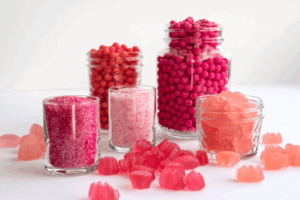Health concerns have led to sugar reduction, as well as the adoption of sugar and sweetener alternatives. International Confectionery explores how feasible it is to replace sugar in confectionery.
Health-conscious attitudes and the rise of healthy confectionery have both influenced an overall reduction in sugar in confectionery. Companies wanting to cater to demands from all kinds of consumers have responded accordingly and introduced free-from and sugar-reduced products, in addition to the introduction of sugar and sweetener alternatives. This, coupled with reduced harvest yields of beet sugar have made sugar alternatives appealing. But how easy is it to incorporate sugar and sweetener alternatives into confectionery?
The confectionery landscape has shifted in the last decade, as attitudes towards sugar have come to characterise cautiousness and even aversion, as its links to health-related issues such as weight gain and subsequent heart disease and diabetes risk, have spawned efforts to tackle the amount of sugar in our food. The UK, for instance, has taken steps to address growing obesity rates, by introducing legislation to oversee the reduction of sugar content in consumer goods and restrict reduced price offers on these foods. Over the Atlantic, the National Confectioners Association (NCA) and Partnership for a Healthier America released a report this year relaying, with excitement, that American confectionery companies are doing more to provide transparency and portion guidance for consumers.
Typically, the sugar that goes into confectionery is sucrose, which is obtained from sugar cane once it’s harvested and crushed to extract juice, which is heated until a syrup is formed. The syrup is then boiled, leaving raw sugar behind, which needs to be refined. For sweeteners, this is usually aspartame, which is 200 times sweeter than sucrose and commonly used as a sugar substitute. Both sucrose and aspartame are linked to a plethora of health issues: sucrose can lead to weight gain, while aspartame is linked to headaches and migraines. It is not only the reduction of sugar in confectionery that seeks to address these associated health concerns, but also by offering sugar and sweetener alternatives. For the confectionery industry where sugar is a primary ingredient used in the processing of chocolate and candy, this has proved a challenge, but one the industry is evolving to address, so confectionery can continue to be bought and enjoyed by consumers with the health-conscious among them.
Innovations in the sweetener and sugar alternatives sector have seen preference towards sugars and sweeteners derived from natural sources. Natural sweeteners can include stevia, which is derived from the stevia plant, and ‘upcycled’ sweeteners which utilise food waste generated from fruit processing including bananas and pears. Processing banana peel into 99.7% erythritol is an ongoing process, notably undertaken by fruit processor Frutco and plant-based ingredient supplier Fooditive who are collaborating in the construction of a biodiesel plant which will process banana and other fruit side streams into natural extracts and sweeteners. In addition to this, cocoa fruit pulp has been used to sweeten chocolate as a substitute for refined sugar, to tackle waste generated from cocoa processing…
To read more see our latest issue here.
Media contact
Caitlin Gittins
Editor, International Confectionery
Tel: +44 (0) 1622 823 920
Email: [email protected]








